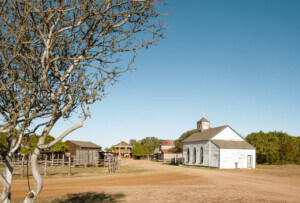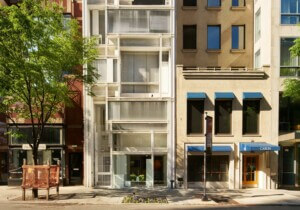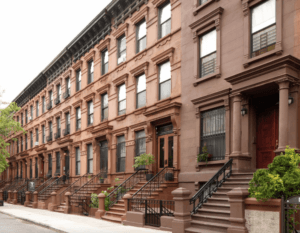To screen or not to screen?
That was the question before New York’s Landmarks Preservation Commission (LPC) on April 28, when panel members reviewed a seemingly innocuous proposal to permanently alter a chain-link fence surrounding a schoolyard in Greenwich Village.
Their review turned into a larger, Jane Jacobsean-discussion about urban playgrounds in general and how a property owner’s push for privacy could end up taking life and vitality off city streets. It raised important questions about the creeping privatization of open spaces in the public realm while also, perhaps ironically, pointing out the difficulty of holding public hearings on Zoom.
The panel was asked to allow the property owner, the Church of St. Luke in the Fields and St. Luke’s School at 487 Hudson Street in the West Village, to cover an existing chain link fence with a faux-ivy vinyl screen that would block views of children playing in a schoolyard.
The commission last year gave St. Luke’s a temporary permit to put up the screen, and now the church and school want to make it permanent. Besides blocking views into the schoolyard, the screen blocks views toward the campus of St. Luke’s, which includes a church dating back to 1821, a rowhouse dating from 1825, and a school built in 1955. Preservation commission approval is required because the property is in the Greenwich Village Historic District.
The request to “alter a fence,” though it appeared to be a minor item on the commissions’ agenda, triggered a lengthy debate over the need for and wisdom of screening playgrounds that traditionally have been open to view, and if so, how best to do so. The commissioners said they were troubled both by the ivy-themed graphic and the very idea of screening the schoolyard.
“I was not aware of this situation and I’m finding myself to be kind of appalled by it,” said vice chairman Frederick Bland, whose remarks set the tone for the discussion. “Not the design per se, although I’m not a fan of the ivy necessarily. But the whole idea of visual privacy of playgrounds. Is this something that’s occurring all over the city?“
Bland, the managing partner of Beyer Blinder Belle Architects and Planners, said his office used to be near the schoolyard of Grace Church on Broadway, “which was lovely and open, and it was wonderful at noontime to see all the kids out playing. I just don’t understand why we’re doing this and, if so, is this a precedent that then everybody’s going to hide and protect their kids playing in playgrounds? I can’t imagine a city like this.”
“My heart is just leaping forward and saying this is a terrible precedent,” he concluded.
Chain link fencing is a very common material for New York City school playgrounds, but “it’s always open and it always allows people to see” in, said commissioner Michael Goldblum. “That’s part of the street life of New York City. It’s part of the street life of Greenwich Village…Seeing that activity is part of the life of the street. So I would not think that any kind of material that blocked that would be appropriate.”
Other commissioners objected to the ivy pattern on the screen.
“The graphic is so dominant. It’s so powerful,” said commissioner Everardo Jefferson. “Maybe there’s a graphic pattern that’s softer, not so dominant.”
“They should just grow English ivy on it and have the real thing,” suggested commissioner John Gustafsson. “This is just awful.”
St. Luke’s operates a coed Episcopal day school for grades JK (Junior Kindergarten) to 8, divided into a lower school and an upper school. The chain-link fence in question is roughly nine feet high and stretches for a block along Christopher Street, between Hudson and Greenwich streets. On the school’s side of the fence is a playground with a half-basketball court in the middle.
Commissioners were told the chain link fence has been in place for years and is “grandfathered in,” meaning it’s allowed to stay and not up for discussion. Last year, commission staffers say. St. Luke’s sought and received a temporary permit to make one 40-foot-long section of the fence three feet higher, with the expectation that a higher fence would help prevent errant basketballs from ending up in the street.
Besides asking to increase the fence’s height in the section corresponding to the basketball court, St. Luke’s last year asked for and received temporary permission to cover the entire length of the fence with a vinyl screen that would block views into the schoolyard from Christopher Street. By the fall of 2019, the faux ivy screen was in place. At this meeting, the property owners were seeking a “certificate of appropriateness” that would make permanent modifications that started out being temporary.
No one from St. Luke’s spoke at the hearing. Instead, St. Luke’s was represented by its design consultant, Signe Nielsen of Mathews Nielsen Landscape Architects. No one from the general public asked to testify about the St. Luke’s item but Manhattan Community Board 2, an advisory group that had reviewed the proposal, sent a resolution recommending denial of the application.
To complicate matters, the April 28 meeting was a virtual hearing held via Zoom. It was just the second time the commission has had a virtual public hearing while its offices and hearing room at 1 Centre Street have been closed due to the COVID-19 pandemic. Nielsen had already submitted the drawings and photos required to support her application. But when it came time for her to begin her presentation to the commissioners, she had trouble with her computer connection and was unable to communicate with them in any intelligible way.
After many Hellos, Director of Preservation Cory Herrala asked staff preservationist James Russiello to start outlining the proposal to the panel. Eventually, with the help of the staff, Nielsen resolved her audio problems and was able to “join” the meeting and address the commission.
At the start of the presentation, commissioner Jefferson asked why St. Luke’s wanted a screen on the fence. “Why not see the playground?”
He was told the owner wanted the screen for privacy reasons. “The purpose of the covering is so that you can’t see into the playground from the street. It’s solid,” Russiello said.
“This is a fence that’s fronting a playground with children of different ages,” Herrala said. “I think there’s been an attempt to provide privacy from people walking by for some time.”
In recent years communities around the country have seen students killed in school shootings, and they’ve taken various steps to increase both security and privacy. Sarah Carroll, the commission chair, told the panel this isn’t the first time administrators of a school in New York City have sought to screen a playground. “I think that many schools do try to create some security and privacy for children playing. It’s not unusual and not the first time we’ve seen a request for privacy for areas that children will be.”
Commissioners also asked why the designers went with the fake ivy pattern.
Nielsen, able to respond at that point, said the ivy was considered more palatable than other options under consideration.
“We had picked ivy because it was neutral, cheerful and far preferable” to alternate choices, she said. “There was some suggestion for whether this vinyl print should be a replication of a brick wall. We did not respond to that, but that was one of the suggestions that had been made by the community board.”
Carroll, who previously served as the commission’s executive director, said she thought the ivy pattern was intended to evoke the “garden nature” of the space between buildings on the St. Luke’s campus.
During the discussion phase of the hearing, a few of the commissioners said they could accept the proposal to keep one section of the fence higher if it would prevent $50 basketballs from going into the street. But no one liked the ivy screen. Some said they would be open to the idea of a more translucent, mesh-like material, like many tennis courts have. Others said they didn’t want a screen at all, or at least a lower screen.
Commissioner Adi Shamir-Baron stressed that there is a difference between a fence and a wall.
“What I object to is that this is no longer a fence at all. Nothing about it is screen-like or fence-like. It’s an opaque, solid wall,” she said. “So the point is that we would be approving a solid wall and the proposal here is for it to be made even taller.”
Shamir-Baron said she would be willing to consider a screen that’s translucent or perforated in some way. “It needs to have transparency,” she said. “It’s not the image that I find problematic but its opacity.”
Commissioner Diana Chapin expressed doubt that the material would age well. “I don’t think it’s going to hold up and look good even if we wanted to have this wall-like effect,” she said.
“If they need some kind of semi-privacy,” said panelist Michael Devonshire, “they could get a neutral mesh and mount it on the inside of the chain-link fence.”
At the end of its discussion period, the panel typically votes to determine whether an application gets approved. In this case, Carroll didn’t let it come to that. She told the panel she thought that because Nielsen had so much technical difficulty at the start of the meeting and wasn’t able to participate fully, the panel ought to take no action and give Nielsen and her clients time to digest their comments and schedule another meeting. It was a polite way of suggesting that they go back to the drawing board.











